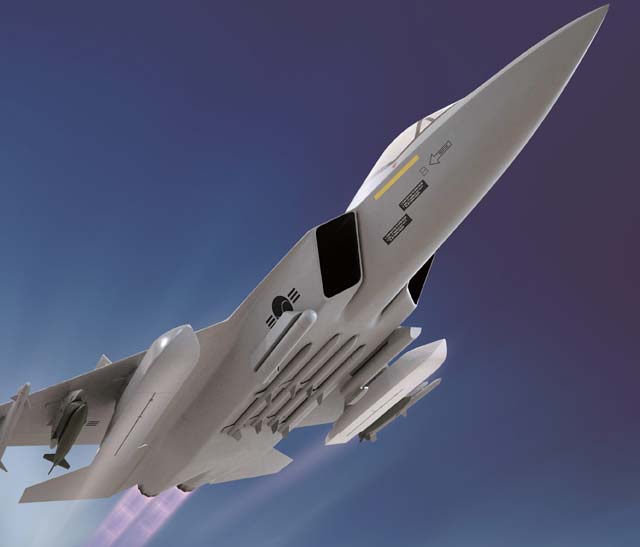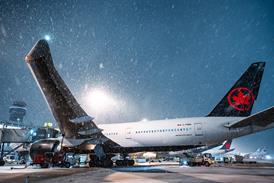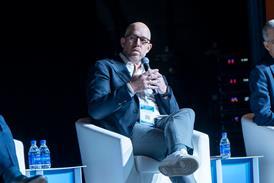Four years ago, at the 2011 instalment of the Seoul Air Show, South Korean officials predicted that 2013 would see the start of development for the country’s long-planned indigenous KFX fighter aircraft. A first flight was likely in 2015, and full scale production in 2021. Seoul would have a 60% share in the project, while prospective partners Indonesia and Turkey would each have 20%. They would provide funds and a degree of participation, but there was no question that Seoul would sit in the cockpit.
The aircraft envisaged was ambitious, far more advanced than any aircraft developed in South Korea. It would vault South Korea from a second tier player in the global aerospace supply chain to a leading systems integrator. Seoul’s Defense Acquisition Programme Administration (DAPA) gave a long list of requirements: fly-by-wire flight controls, hands-on-throttle-and-stick pilot controls, a helmet-mounted display and a night vision imaging system. Low-observable technologies would reduce the jet’s radar cross section (RCS). KFX would have an active electronically scanned array (AESA) radar and an infrared search and track (IRST) sensor.
As is all too common in the world of fighter development, things have not gone to plan. Turkey ended up not joining KFX, deciding instead to build its own indigenous fighter, the TFX. By the 2013 Seoul Air Show, officials were still in talks with various suppliers, but no prototype was on the drawing board. Indeed, it was still some way from deciding whether Korea Aerospace Industries (KAI), the country’s leading airframer, or KAL-ASD, a unit of Korean Air, would develop KFX.
Perhaps the single biggest element in the delays was Seoul’s torturous F-X III fighter competition, the technology transfer offsets of which are earmarked for KFX work. Contenders for the bitterly-fought F-X III deal included the Lockheed Martin F-35, Boeing’s proposed F-15 Silent Eagle, and the Eurofighter Typhoon. Eurofighter was always deemed an outsider for the competition, but in a nod to KFX, it apparently offered an extremely lucrative technology transfer package. In 2013, after last minute scare from the F-15SE, the F-35 emerged as the winner of F-X III, although Seoul cut the airframe requirement from 60 to 40 examples, citing budgetary issues.
At the 2013 show, KAI had models of both single-engined and twin-engined KFX proposals. KAI’s engineers favoured a single-engined jet as this would simplify production and keep costs down. They also felt it would have better export potential, a crucial consideration for a successful programme. Seoul’s Agency of Defense Development (ADD) disagreed. It preferred a twin-engined design resembling the F-35, although not as capable as the US type. South Korea’s air force also wanted two engines. Officers reckoned that the KFX will need to carry bigger, heavier missiles over its service life, and one day possibly accommodate power-hungry directed-energy weapons.
Finally, in May 2015 it emerged that South Korea’s DAPA had awarded KAI preferred bidder status for the programme, with Lockheed Martin tapped as the foreign technical assistance company. KAI’s success followed a forced re-tendering of the contract in February, when KAL-ASD (partnered with Airbus Defence & Space) apparently decided not to submit a bid.
“The benefits for South Korea from the KFX program involve providing a modern replacement for the air force’s fleet of ageing F-4 Phantoms and Northrop F-5s,” says Forecast International analyst Daniel Darling. “[It is also intended to] add to local aerospace industry innovation and competency through knowhow gleaned from KAI teaming with Lockheed Martin on the aircraft's development, and reducing what would otherwise be even more significant costs to the procurement portion of South Korea's defence budget by spreading the cost burden of the project, with 20 percent to be fronted by the KAI-Lockheed team, with another 20 percent by Indonesia.”
Teal Group analyst Richard Aboulafia agrees that the KFX programme has the potential to advance South Korea’s aerospace sector.
“KFX would help South Korean industry achieve a new level of capability and autonomy,” he says. “If they designed it with the export market in mind, it would potentially establish South Korean industry as a player in the global defence market.”
KFX’s export potential, however, gets to one of the programme’s main stumbling blocks: how much taxpayer-funded technology will foreign partners, i.e. Washington DC, be willing to part with? KFX underlines the paradox inherent in defence offset arrangements: to win the business in developing nations, western defence contractors must assist programmes intended to create competitive products.

The ambitious KFX fighter project has fallen foul of US government export rules
Korean Aerospace Industries
South Korean defence experts have long fretted about US willingness to part with sensitive technologies. Sources close to the programme say the biggest challenge is obtaining export licences from the US government related to AESA technology, engines, system integration, and other areas. So prominent is this factor in their minds that they refer to it in shorthand as the “The E.L. issue.”
To get some sense about how prickly the US can be about technology, it is useful to look at the KAI T-50 programme, in which Lockheed Martin provided indispensable assistance. A source familiar with the T-50 says that Washington placed substantial restrictions on Jakarta’s acquisition of 16 T-50 aircraft, particularly around the aircraft’s radar and mission computer. In late 2014, South Korea’s Black Eagles display team, which flies the aerobatic T-50B variant of the trainer, cancelled its appearance at Airshow China in Zhuhai. It gave no reason for the cancellation, but media reports suggested that the US was displeased that the aircraft, with its large amount of proprietary American content, would attend a show in mainland China.
South Korean export licence fears were realised in late September 2015 when DAPA dropped a bombshell. It announced that the US had declined to provide export licences for four technologies deemed fundamental to KFX: AESA radars, IRST, electro-optical target tracking devices, and jammers. The news created a furore in the South Korean media, with reports saying that the country’s leadership will conduct an investigation into the programme. The reports suggest that DAPA failed to keep the nation’s leadership up to speed on progress with export licences.
A key theme in Korean media coverage of the issue is that technologies for the KFX programme were to have been derived from offsets related to the F-35 buy. Some question DAPA’s wisdom in selecting the F-35 when technology transfer was apparently not assured. In addition to the four “core” technologies that have been denied, 21 other technologies have been approved by the US Defense Department, but still await State Department approval.
Although DAPA made no mention of radar absorbent materials (RAM) in its September statement, this will be another area where KFX will face stiff headwinds. In 2011, Korean officials said they would deploy the aircraft in 2020 (a target that has long since been missed) with a “basic” stealth capability, although they declined to clarify what this meant. They contended that shaping an airframe to reduce its RCS is no great secret. All well and good, but it is unlikely that Seoul’s F-35 acquisition through the US Foreign Military Sales mechanism includes provisions for export licences related to the secret formulas used in RAM.
Meanwhile, through all the twists and turns around KFX, one constant has been Indonesia. There can be little doubt about Jakarta’s interest in KFX, with its defence ministry periodically issuing statements reaffirming its commitment to the programme. Most recently, it announced the laying of the first brick of a KFX facility at the Indonesian Aerospace production centre in Bandung. Another apparent constant is the planned production run for KFX, which foresees 120 examples going to South Korea and 80 to Indonesia.
Unfortunately, however attractive Jakarta’s cash may be for developing KFX, the Southeast Asian nation is not the sort of partner Washington is likely to trust with sensitive technologies, let alone tightly guarded secrets such as RAM. Indeed, only in 2006 did Washington lift an arms embargo targeting Indonesia.
Several Korean sources blame Indonesia’s involvement in the programme for US reluctance to issue export licences. They claim that Jakarta is a lightweight in the global aerospace industry, and question how much value it can bring to the table. One expert says that jettisoning Indonesia would be a good way to placate Washington.
In an apparent bow to Washington’s likely concerns about Indonesian involvement, it is currently planned to provide Jakarta with jets in a Block I configuration. Block I would incorporate no stealth coatings – although it may employ some RCS shaping. It would include conformal fuel tanks, but no internal carriage of weapons. Block II, which would go to the South Korean air force, would see conformal fuel tanks in addition to internal weapons carriage, as well as the possible introduction of stealth coatings.
If the Block I idea is not sufficient to satisfy Washington, another way to keep Indonesia in the programme and gain export licences could be developing two broadly different variants of the jet, the KFX and IFX. This proposal would see the latter produced with greatly reduced capabilities. This twin track approach, however, would drive up costs and complexity. One expert says that the current export licence fiasco could perhaps lead to Seoul paring back its ambitions for the jet, and reverting to the single-engined design favoured by KAI.
Another major challenge for KFX – and an area where US help will be invaluable – is software. South Korean officials have said in the past that whereas South Korea is capable of producing advanced sensors and systems, it has little experience with the sensor fusion that is crucial in giving the pilot an integrated picture of the battle space. South Korea’s only indigenous combat aircraft, the FA-50 variant of the T-50, is an effective basic fighter, and sufficient to boost airframe numbers as F-5s and F-4s are retired, but it is a far, far cry from what is envisaged for KFX.
“Although South Korea acquired technology from developing KT-1 and T-50 to develop fighter jets, the nation is yet to possess core technologies,” says Kim Dae Young, secretary general of Korea Defense & Security Forum (KODEF), and a consultant to the South Korean government. “The core technology transfer will be highly dependent on the US government’s export license.”
Like other experts Flightglobal spoke with for this story, he echoes the view that Jakarta’s involvement in the programme is probably an irritant for the US. According to Kim, one backup plan is to obtain core technologies from Europe. “The other issue is to figure out how much localisation will be required. In the case of the AESA radar, which is a core requirement for KFX, there are mixed opinions between the government and the aerospace industries about whether to develop an indigenous AESA radar or to purchase the radar from abroad.”

Indonesia's presence in the KFX programme is thought to have alienated Washington
Korean Aerospace Industries
He adds that the programme is likely to cost around $15 billion, and be the biggest procurement project in South Korea’s history. “As we’ve seen from several other countries’ next-generation fighter jet programs, it is highly likely that the programme will go over budget. There is budget for KFX system development, but if the development programme does not go well, more budget will have to be invested. This will be a big burden for the next government administration.”
The KFX’s engines appear to have boiled down to two options in the 20,000lb thrust range: the General Electric F414 that powers the Super Hornet, and the Eurojet EJ200 that powers the Eurofighter Typhoon; Eurojet consortium company Rolls-Royce is leading the EJ200 KFX campaign. Becoming the KFX’s powerplant would be of tremendous benefit to both engine programmes, but industry experts say the GE engine has a clear edge. South Korea has long experience with American-built fighters and fighter engines. Local firm Samsung Techwin has produced a number of GE engines under licence, such as the F100 for the KF-16, F110 for the F-15K, and F404 for the T-50.
Of the pair, the GE engine also looks destined for a longer production run. Though its key platforms, the F/A-18 E/F and EA-18G, are likely to exit production by the end of the decade, it has found a home on foreign types such as the Hindustan Aeronautics Tejas Mk II and the new Saab Gripen NG.
“Based on the South Korea aerospace industry’s opinion, GE’s F414 is the strongest candidate in terms of capability and price,” says KODEF’s Kim. He notes that GE has more experience with indigenous programmes, including the T-50 and FA-50, which are powered by the F404.
“GE has also been building long-term relationships with South Korea’s aerospace industries and Hanhwa Techwin is producing various GE engine parts at the moment,” he adds. “EuroJet’s biggest weakness is that it only has experience in the Eurofighter programme. In addition, the F414 engine has a lot of field experience with F/A-18 E/F. Therefore, I believe ROKAF has more confidence with GE’s engine.”
One KFX-related field where DAPA appears keen to develop its own solutions with less input from foreign partners is weapons. South Korea’s ADD has worked with industry to produce a 225kg guided weapon called the Korea GPS-guided bomb (KGGB), which is fundamentally an indigenous version of Boeing joint direct attack munition (JDAM), equipped with a range-extending wing-kit. Footage from South Korean defence firm LIG Nex1 shows the weapon being dropped from platforms including the FA-50, F-5, and F-15. Seoul has also expressed interest in developing air-to-air weapons for KFX.
Another area where Seoul has developed some useful expertise is the internal carriage of weapons. In 2010, Boeing and KAI entered a memorandum of understanding under which the Korean company would design, develop, and produce conformal weapons bays for the F-15SE, runner up in F-X III. Although the Silent Eagle never emerged as a production variant of the F-15, in June 2012 Boeing said that it had completed wind tunnel tests for the type’s CWBs.
South Korea can bring these valuable technologies to the KFX programme, but far more will be needed to develop an effective, modern fighter. The KFX simply cannot escape the export licence issue. Despite Washington’s current intransigence, there are hopes that the US and South Korean governments will be able to sort through their differences and move KFX forward. Indonesia is still integral to the programme, but if Seoul is forced to choose between Jakarta and Washington there can be little doubt where its loyalties lie.
Chae Woo-seok, chairman of the Korea Association of Defense Industry Studies, casts KFX as a natural progression for the nation’s aerospace industry.
“The aerospace sector enhances our self defence capability and lowers our dependence on foreign equipment,” he says. “If we design and develop fighters at home, they can be optimised to our own environment. It will also be easy to operate and maintain in terms of logistics. Considering our current level of technology, it’s time to develop our own fighters.”
Source: FlightGlobal.com























